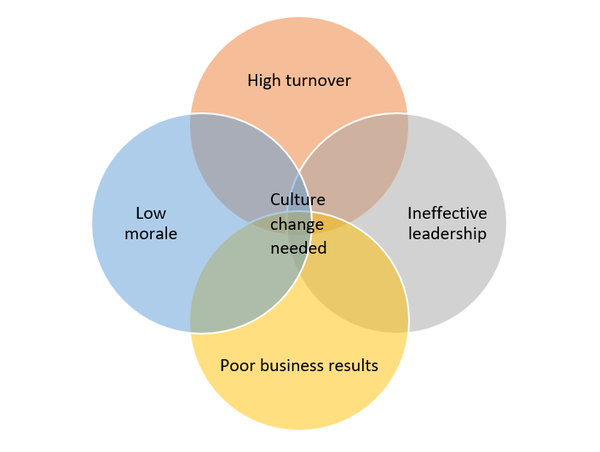THE WORLD’S #1 EXECUTIVE COACHING AND BUSINESS COACHING BLOG SINCE 2017.
The Culture Change Consultant and Your Company’s Transformation
February 21, 2025 | Category: Blog, Cultural Transformation | Last updated on: March 12, 2025

The word “culture” traces its roots (appropriately) to agriculture. It comes from the Latin word “cultura”, which directly refers to the act of preparing the earth for crops and also encompasses the act of care and guarding.
It wasn’t until the nineteenth century that the word “culture” became associated with cultivation through education, as well as refinement and improvement. In many of today’s contexts, the word could often be replaced by “zeitgeist,” or the defining spirit of an organization at a given time. But it’s important that organizational leaders look deeper than zeitgeist to understand the underlying elements that give a particular organization at a particular time its unique spirit.
Strong culture requires good environmental conditions and regular tending, just like a garden.
Culture develops in any cohesive organization, whether formally or informally. While allowing culture to develop organically may seem most benevolent, that is rarely the best approach. One thing is the culture that develops organically among a small group of friends. The culture that grows unchecked within a business is quite another.
Leaders shape culture. It must be part of their business strategy, like employee satisfaction, but they don’t dictate it. Leaders shape and guide corporate culture like a gardener shapes hedges so they’re maximally functional in all senses.
Strong Company Culture
Strong company culture is, in general, superior to weak company culture. If you have ever been on a team or worked for a company with strong cohesiveness and team spirit, you understand this. But let’s take another look at the word “culture.” It’s also where the word “cult” comes from. A too strong, managed, and rigid culture turns intelligent, capable people into little more than robots (albeit robots with an overwhelming sense of duty and purpose).
Charisma in a leader is generally good because great leaders inspire their followers to achieve their own greatness. However, when charisma mutates into control, sound and naturally flourishing parts of a culture may be chopped off and discarded. New ideas may be rejected without thought. Everything becomes about “the culture,” and ultimately, that can doom a business.
A strong, thriving company culture is balanced. It means the people involved have aligned goals and work toward a common, overriding mission.
However, it also means that people are free to use their brains, innovate, and have their own ideas. Thus, people have appropriate levels of autonomy.
Weak Company Culture
Weak company cultures are distressingly common. A business with a weak culture is little more than a place to go to work to get paid. People are content to do what is expected of them, but they do not understand the company’s mission and goals. Therefore, the conditions aren’t right for growth and achievement.
Company cultures are often weak because founders and/or leaders shirk their responsibility of tilling and enriching the soil of company culture. Or leaders may make an initial statement about what they want the company culture to be but then fail to do the work necessary to make it happen. The result is a business that does what is necessary but fails to move forward as it should.
Another problem with weak company culture is that it makes it easier for bad elements of culture to take root and grow. Maybe a department head provides weak leadership, and as a result, a power-hungry department member takes it upon themselves to create a self-serving culture. It’s a recipe for morale problems, difficult recruiting, and high staff turnover.
How to Know if Change Is Necessary
In a healthy company, slight cultural changes happen frequently because people grow and learn, staff members come and go, and the world is always changing. So, cultural change on a low level always happens in a healthy organization.
But sometimes, a major corporate culture transformation is in order, and leaders often don’t realize this until things have become difficult. Maybe staff turnover has increased steadily, and nobody has bothered to figure out why. Or maybe a leader has, for whatever reason, chosen to shirk their leadership responsibilities, causing chaos among those being led.
It’s not always easy to recognize when significant cultural transformation is necessary. Still, leaders who listen and track key metrics like productivity, efficiency, staff turnover, and revenues can recognize the signs.
Naturally, any of these metrics can fall off for reasons other than cultural problems. Still, when they drop seemingly for no reason, perhaps it’s time to examine culture more closely and determine whether significant changes are necessary.
Weak or bad culture is often expressed by a number of factors.
Push-Back from Team Members
Some people will resist cultural change initiatives. It’s inevitable. Even in a bad company culture, there will be people who have created their own little fiefdoms and power positions and will be reluctant to give them up.
There will also be people who have been working on autopilot for a long time who will be annoyed that they may be required to start putting thought into their work. But if you know things are bad and you experience significant push-back, it’s a sign that cultural changes are needed and not a moment too soon.
Dealing with pushback requires understanding why it occurs and addressing the underlying issues. Some people will almost inevitably bow out immediately and resign, unable or unwilling to do the work necessary to improve the culture. That’s too bad, but it can’t be avoided.
Just remember that when corporate culture is bad enough to affect revenue and productivity, everyone notices, and plenty of people are relieved that something is being done about it.
Major cultural change requires effort on everyone’s part, but those who genuinely care about the organization, its goals, and its future will be willing to overcome their reluctance.
Results of Positive Culture Change
What can an organization expect from well-intentioned, well-planned, and well-executed cultural change and a thriving organizational culture? Plenty:
- Better employee retention – because workers who feel valued and know they are contributing to organizational success tend to stay around longer
- Improved reputation – among existing employees, potential employees, the industry, and the business world
- Higher productivity – because team members are motivated to give their best when they believe their mission is worthwhile
- Higher quality of products and services – because companies that value high standards and provide their employees with the right atmosphere and tools for fulfilling those standards tend to improve excellence in all work categories
A strong, positive corporate culture means you spend less time hiring and training new people, and when you do hire, you have a better candidate pool from which to choose.
Have you ever noticed that the companies on “Best Places to Work” rankings tend to be highly successful ones? The bottom line is that when people feel good about going to work and about what their company does, they’re more willing to go that extra mile to achieve goals and apply excellence than when work is just a means to a paycheck.
Necessary Conditions for Change
A defined starting point, goals, and buy-in are necessary conditions for successful change.
To know how to get to your destination, you have to know where you are now.
You first need to know your starting point to find where you want to go and lead an organization in transforming organizational culture towards a desired culture.
Before improving your existing culture, you must clearly understand it—warts and all.
Just as the master gardener tests the soil to determine which nutrients are lacking and which are abundant, the leaders initiating corporate culture change must understand the current conditions, including what is missing and what is overrepresented.
Goals are necessary for positive cultural change. What do you want to be able to say about your organization one year from now? What headaches do you want to eliminate as much as possible through culture change? How much revenue growth is reasonable to expect? What percentage drop in employee turnover is your goal? Without goals, cultural change efforts will fall flat.
Finally, for cultural change to succeed, buy-in must come from people at every level of the organization, from the CEO to the entry-level employee. You can’t expect every employee to like everything about the change process, but you must be confident in their support.
Culture Change and Change Management
Change management has to do with discipline. You can’t make a plan for cultural change, then say “Go!” and expect it to happen like a row of dominoes falling. While change management in practice is unique to every organization, it typically involves the following steps:
- Identifying groups and individuals who will change
- Identifying how those groups and individuals must change (whether in terms of responsibilities, shifts, job titles, etc.)
- Creation of a customized plan for ensuring affected employees receive the leadership, training, and coaching they need to make necessary changes
- Adapting project or process management to accommodate cultural change
- Monitoring the change process and addressing issues as they arise
- Tracking change and outcomes
- Documenting lessons learned and best practices
The Steps to Culture Change
The overarching steps to workplace culture change are definition, alignment, and management.
To define cultural change, you must begin with your end goals in mind. The definition process itself involves:
- Evaluating your current culture and how it performs
- Clarifying your initial vision of change in terms of leveraging strengths and addressing weaknesses
- Creating a plan to communicate how everyone will work together to address weaknesses and double down on strengths
- Clearly defining values and expected behaviors for “living your values”
Alignment of goals defines how everyone will work together toward the organization’s mission:
- Defining and sharing three to five actionable strategic priorities to focus on
- Engaging the team in defining the objectives that lead to accomplishing goals. Such objectives may include better accountability, tracking key metrics, or regular recognition of excellence.
- Defining a handful of key metrics that support goals and performance priorities
Defining goals and planning how to meet objectives and milestones is a crucial part of cultural change.
Managing change and creating a high-performance culture is where the rubber meets the road. It is about the discipline to see change through. Steps typically include:
- Developing a system to track the status of change
- Ensuring effective communication
- Facilitating positive collaboration
- Building on motivation throughout the change process through feedback, recognition, transparency, and celebration of success, as well as addressing issues as they arise rather than letting them smolder
What Culture Change Consultants Do
Culture change consultants shepherd client companies through the process of cultural change. They don’t perform or direct change, but they help client organization leadership plan, execute, and manage change based on proven performance outcomes.
Company culture consultants are vital in guiding organizational culture transformation and ensuring alignment between leadership, employees, and business objectives.
A culture change consultant is an expert who helps companies assess and reshape their workplace dynamics to drive sustainable growth.
Culture consultants help organizations establish and maintain such a culture that fosters collaboration, innovation, and long-term growth.
Culture Change Assessments
Assessment is an important skill for culture change consultants because understanding the root causes of cultural issues is paramount. Typically, they use a range of cultural assessment instruments, supplemented by conversations with client organization personnel and comparative industry analysis, to accurately represent the client’s strengths and weaknesses.
Culture change consultants also know how to measure and quantify culture change so clients understand where they began, where they ended up, and what factors were most important in the transition.
Effective culture change consultation requires a number of key skills.
Some culture change consultants offer specialized services related to safety. When cultural factors influence safety practices, the results can be devastating. Culture change consultants specializing in safety issues help implement changes designed to improve organizational safety.
Tools and Techniques Used by Culture Change Consultants
Most cultural change consultants are equipped with a collection of tools that can be used at various phases to assess current status, map out plans, and track changes. Many begin their work with client organizations by administering surveys and interviews to produce a clear picture of the organization’s cultural status.
During the change process, consultants may administer additional assessments to measure progress toward goals. When the consultant’s relationship with the client organization ends, they will likely perform additional assessments and measurements to clarify which goals have been met, which have not, lessons learned, and best practices.
In addition, some culture change consultants offer services that organizations can use even if they do not hire a consultant. These services may include courses, self-administered assessments, workshops, and keynote speeches. Some may offer specialized courses, such as safety culture assessment and improvement.
Is There Such a Thing as Too Much Change?
Change is inevitable, and resisting it is ultimately futile. However, change management is also necessary to prevent the “change” mentality from getting out of control.
Organizations can try to implement too much change at once, making the upheaval feel permanent rather than temporary. Team members may feel they cannot gain their footing before something else important changes.
Even organizations that require major cultural change for survival must tackle change in a methodical, measured way, or they risk experiencing all of the bad outcomes of a bad culture at once. For example, a company may be mired in complacency to the point where even the simplest innovations are met with contempt. Should that company decide to force innovation company-wide at once, many people will probably jump ship rather than try to navigate the major changes ahead.
Too much change too quickly can exacerbate cultural problems. Major cultural changes can occur, but they do not happen overnight.
Implementing smaller changes to pursue major cultural change will generally be more effective than scrapping everything and starting over.
Is it the Right Time to Hire a Culture Consultant for your Organization?
Culture change consultants exist because culture change is difficult. Even when everyone in an organization knows that things must change, making those changes can be challenging and tiring.
However, with the right culture change consultant, a plan can be created to identify specific changes, prioritize them, and map out a path to making them happen.
Culture change consultants know the importance of a strong, positive culture and know how to help organizations achieve it.
Culture change depends on buy-in from everyone, but top leaders must champion it to have the greatest positive effect. A surprisingly big majority of employees think that culture change is needed in their organization, and this alone should prompt corporate leadership to plan to regularly assess company culture and be prepared to change elements of it.
Leadership in today’s business environment must be willing to change and adapt because the world outside is changing so rapidly. Organizations that stubbornly cling to old ways of doing things may hang on for a while as they are, but eventually, change will happen whether they like it or not.
It is far better for these organizations to understand, embrace, plan for, and manage change, particularly if the corporate culture is weak or negative.
Conclusion
For years, business innovators and experts have emphasized the importance of corporate culture. They also know that culture is a living entity and something that will inevitably change over time. It is the organizations that value positive culture, that test the soil, till the ground, and pull out the weeds that will have organizations that thrive and grow.
John Mattone Global has helped companies worldwide transform their cultures by integrating leadership development, tailored strategies, and structured change management processes.
Investing in culture consulting is one of the most impactful decisions a company can make, ensuring long-term resilience and competitive advantage. By taking intentional steps toward cultural excellence, businesses can create an environment where people thrive, innovation flourishes, and success becomes a lasting reality.
Take the first step toward a thriving, high-performance workplace today.
Schedule your free discovery session with John Mattone Global today and transform your organization’s culture for lasting success.








